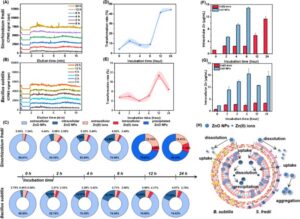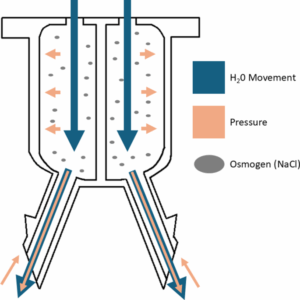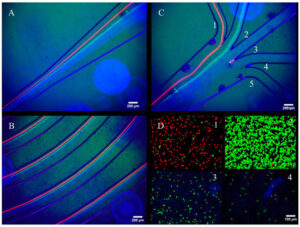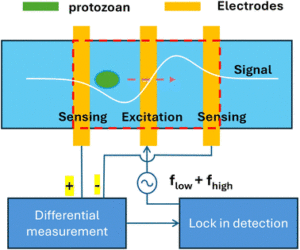The Gale Group enjoyed a game of pool at the Student Union building this past Friday.

The Gale Group enjoyed a game of pool at the Student Union building this past Friday.

This Friday, the Gale Group enjoyed lunch at Ruth’s Diner and the beautiful fall weather.

Congratulations to the following students from the Gale Group who have successfully defended and/or graduated within the past year!
Yunhao Peng
Greg Liddiard
Afroza Tabassum Akhi
Shamima Juthi
Sabin Nepal
Matt Nelson

Brady Goenner et al. recently published “An open source platform to automate the design, verification, and manufacture of 3D printed microfluidic devices” in Scientific Reports.
Several barriers to widespread microfluidic adoption exist, including high initial fabrication costs and the labor-intensive development process. To address these barriers, a toolchain for the design, verification, and manufacturing of 3D printed microfluidic devices is presented. This work builds on existing electronic design automation (EDA) tools, yielding a toolchain that automatically lays out a microfluidic device from a library of components, simulates the device, and produces a 3D CAD file for manufacture via 3D printing. The process is validated by automatically designing and fabricating a calcium quantification assay. The full article can be found at https://doi.org/10.1038/s41598-025-15976-9.
This past Friday, the Gale Group hiked Gloria Falls up Little Cottonwood Canyon. It was a great group activity to kick off the semester and enjoy the end of summer in Utah!


“Real-time monitoring of culture medium- and species-specific transformation of zinc oxide nanoparticles in bacterial systems using coupled CyElFFF-ICPMS,” authored by Weichen Zhao et al., was recently accepted in Microchemical Journal.
The article outlines the use of an online-coupled cyclical electrical field-flow fractionation and inductively coupled plasma mass spectrometry (CyElFFF-ICPMS) system for the quantification and characterization of the promising nanoagrochemicals of zinc oxide nanoparticles (ZnO NPs) and Zn(II) ions. Using the CyElFFF-ICPMS system, bacillus subtilis is found to stabilize ZnO NPs while sinorhizobium fredii promotes extracellular ZnO NP aggregation and dissolution. After 6 h, intracellular transformation significantly diverges. These findings demonstrate that the stability, transformation, and intracellular fate of ZnO NPs are highly governed by bacterial species-species interactions. The intracellular transformation and distribution of ZnO NPs in bacterial systems is displayed in the figure and the full article can be found at https://doi.org/10.1016/j.microc.2025.114926.

Ata Ullah and Jade Bookwalter et. al recently published “An Osmosis-driven 3D-printed brain implant for drug delivery” in Biomedical Microdevices.
To combat glioblastoma, a highly malignant brain tumor, several different drug-loaded devices have been developed to suppress tumor recurrence. However, these implants have limited effectiveness and often fail due to clogging, reflux, and limitations in intracranial implantation. Therefore, this article outlines the design, fabrication, and results of an osmosis-driven, 3D-printed brain implant. Featuring dual reservoirs, osmotic membranes, and precision-engineered needles, the implant achieves flow rates of 2.5±0.1 µl/Hr and diffusion distance up to 15.5±0.4 mm. A schematic of the working principle of the device is displayed in the figure and the full article can be found at https://doi.org/10.1007/s10544-025-00759-w.

“Application of Inertial Microfluidics for Isolation and Removal of Round Spermatids from a Spermatogenic Cell Sample to Assist In-Vitro Human Spermatogenesis” authored by Sabin Nepal, Joey Casalini, Alex Jafek, and Bruce Gale was recently published in Micromachines.
The article outlines the used of inertial microfluidics for isolating round spermatids from other germ cells and purifying spermatogenic cells as a way of improving in-vitro spermatogenesis to address male infertility. A custom PDMS microfluidic spiral channel for performing separation is designed, fabricated, and tested. The custom device does not experience clogging issues, a problem encountered in a commercially available spiral device. Additionally, the fabricated device achieves 86% purity in a single pass, an improvement over the 38% seen with STA-PUT – a method based on velocity sedimentation commonly used in this application. Validation results of the fabricated device are shown in the figure with the full article being found at https://doi.org/10.3390/mi16050500.

Authored by Yunhao Peng, Bruce K. Gale, and Himanshu J. Sant, “Waterborne protozoan parasite detection using two-frequency impedance flow cytometry” was recently published in Analytical Methods.
A common cause of gastrointestinal diseases, waterborne parasitic protozoa are micron-sized parasites present in water sources. Therefore, the article outlines the development of a microfluidic water monitoring system based on impedance flow cytometry for the detection of these parasites. By utilizing parallel rather than coplanar electrodes, a limit detection of <0.1% volume ratio is achieved. Additionally, to improve sample discrimination, both a low and high frequency are applied simultaneously, making the method outlined in the article distinct from other proposed systems. A schematic of the monitoring system is displayed in the figure and the full journal article can be found at https://doi.org/10.1039/D5AY00184F.

“A spiral channel with integrated microelectrodes for label-free particle lateral position and size characterization,” authored by Yunhao Peng, Bruce K. Gale, and Himanshu J. Sant, was recently published in Biomedical Microdevices.
In the article, a spiral-shaped microfluidic channel integrated with modified-trident shaped microelectrodes is utilized to analyze and quantify separation of different sized particles. Lateral particle position corresponds to the ratio of peak amplitudes, while peak amplitude indicates particle size and vertical position. The device yields a particle size estimate sensitivity of 2.15 µm/mV. The device fabrication process is displayed in the figure and the full journal article can be found at https://doi.org/10.1007/s10544-025-00742-5.